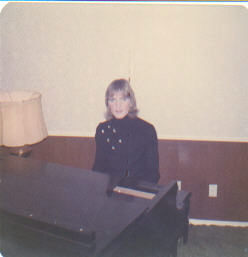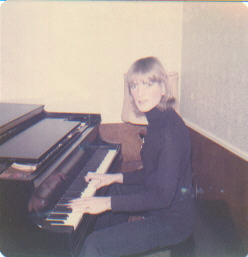

"Baldwin Piano Manufacturing History"


"Danny Piano Chesnut 1973, and My New Baldwin 6'3" Artist Concert Grand"
The story of Baldwin Pianos is one that parallels the frontier spirit, ingenuity, and perseverance that's comprised American history itself. From its humble beginnings in the mid 1800s, the company has adhered to the highest standards in the production of fine keyboard instruments. Today, that commitment to excellence is a testament to the backbone and pride of small-town America.
Founded in Cincinnati in 1862 by music teacher Dwight Hamilton Baldwin, the Baldwin company began as a retail seller of pianos and organs. From the start, D. H. Baldwin demonstrated a gift for hiring quality employees, one of whom was Civil War veteran Lucien Wulsin. Wulsin accepted a partnership in the company in 1873, and he and Baldwin established sales outlets in Louisville, Indianapolis, and several smaller cities. In 1899, the two began designing and building their own keyboard instruments. Three years later the Baldwin Piano Company was established, and the following year the partners shipped out the first piano manufactured under their own roof.
Both D.H. Baldwin and his wife died in 1899, designating that their 80 percent share in the company go to the Presbyterian Church. Wulsin purchased their stake, however, and subsequently merged the various Baldwin businesses to form The Baldwin Corporation. Under Wulsin's leadership, the company quickly achieved the goal of manufacturing "the best piano that could be built." A Baldwin concert grand won the coveted Grand Prix Award in Paris in 1900, then took top honors at World's Fairs in St. Louis (1904) and London (1914). Many prestigious artists—including Igor Stavinsky, Bela Bartok, and Wilhelm Backhous—made Baldwin grand pianos their instrument of choice.
In the early 1920s, in addition to manufacturing traditional pianos, Baldwin marketed player pianos in both grand and vertical styles. The popularity of these instruments fueled explosive growth during the first half of the Roaring Twenties, but with the advent of radio in 1927, the demand for "players" fell precipitously. That decline, combined with the Great Depression, forced many piano companies into bankruptcy. Abetted by a fund set aside for "unforeseen contingencies," however, Baldwin weathered the hard times, and by the end of the 1930s could rightly claim its place as the leading piano company in America.
Baldwin undertook pioneering sound-production research during this period, getting assistance from the Physics Department at the University of Cincinnati. These studies were interrupted in 1941, however, when the company's facilities were enlisted in the American effort during World War II. Baldwin applied its woodworking expertise to the manufacture of airplane wings and fuselage parts. As a result, new veneering techniques were developed, which subsequently became the basis for improved piano construction and greater tuning stability.
A booming postwar economy, combined with growing demand for organs for church and residential use, powered sales for Baldwin during the 1950s. As that decade ended, the company began moving its manufacturing operations from Cincinnati to locations in the South. Plants in Arkansas, Mississippi and Mexico eventually replaced the original factory. The period coincided with the introduction of the SD10 Concert Grand, an innovative piano that prompted TIME magazine to proclaim that the course of music would have been much different had Beethoven benefited from such an instrument. The SD10 has since become the favored instrument for countless artists.
The next three decades were marked by dizzying heights and challenging lows for Baldwin. Concurrent with an ongoing dedication to building quality instruments, the company entered the financial services industry in the 1970s, expanding into a $9 billion conglomerate known as Baldwin-United Corporation. A decade later the conglomerate fell into bankruptcy, but in resilient fashion, the core business of Baldwin Piano and Organ emerged intact. Further challenges confronted the company in the ensuing years, culminating in another near-bankruptcy in 2001. In keeping with its colored history, however, exciting times and a phoenix-like rise lay just ahead.
"We're really pumped. We're still going to make pianos the old-fashioned way, and we're still going to sell our traditional pianos. But these custom pianos are exciting too."
So says Bob Sowell, a member of the Baldwin team for 38 years, and currently the company's Operations Manager. Since the Gibson Guitar Corporation acquired Baldwin in November 2001, such enthusiasm has permeated the Trumann, Arkansas-based manufacturing plant. Staffed with 113 employees, the facility is comprised mostly of skilled wood-workers who take tremendous pride in the products of their labors.
"Everything is hand-crafted," says Tracy McDaniel, who serves as Production Manager. "Very few machines are involved. It's all done by the operator. Most of the employees undergo a six- to eight-week training period. It's all about attention to detail. We teach that quality comes before numbers of instruments produced."
That philosophy has always prevailed at Baldwin, but in the aftermath of Gibson's acquisition, a renewed dedication has taken hold. In addition to consolidating production under one roof—until recently, Baldwin grands were manufactured at a plant in Conway, Arkansas—Gibson has expanded the product line to include theme-based and artist-based instruments. The teamwork atmosphere—and the prospect of hands-on involvement from artists such as Henry Butler and B.B. King—has injected new life into the small-town operation.
"Our sales have always been geared toward homeowners, and to the parents of young children," says Sowell. "Gibson, on the other hand, markets to a broad spectrum. Their influence on us has been in the production of custom pianos—with different colors and different designs—that we're marketing to country stars and rock stars. And of course we still have our classical base as well."
Indeed, both Sowell and McDaniel emphasize that celebrity and tradition are not mutually exclusive. It's fair to say, in fact, that tradition—and quality—are the factors that have prompted recent visits by high-profile artists to the Trumann facility. Sowell points out that Jon Secada spent an entire day at the factory—not just selecting a piano, but also watching as construction of an instrument unfolded. What tends to impress most, says Sowell, is the precision involved in the process.
"Consider that a grand piano may be nine feet long," he says. "That entire piano is built to within 1/32" or 1/16" specifications. Everything is done by hand—that's true of the verticals as well—and each grand piano has a book associated with it. Every operator who touches the piano signs that book. The idea is to ensure accountability—and to instill pride. That record is kept for posterity."
"We get to work on the pianos of famous people," she says. "But that doesn't mean we put any less work into a piano that's sold to a general customer. When you work on a piano that you know will be played by a major artist, that instills a pride that carries over into all your work."
In the end, both Sowell and McDaniel credit Baldwin's success to the work ethic of the people of Trumann, who have also furthered the brand's deserved reputation as "America's Favorite Piano." The town's mayor, Sheila Walters, describes the employees of Baldwin as "friendly, warm, and welcoming—and great for our town."
Sowell also points out that the involvement of Gibson has afforded the company the best of two worlds.
"We're small enough to have a family atmosphere, but we also enjoy the largesse of Gibson—a multi-national company,” Sowell says. “We’re in a growth mode and we're hiring new people. Baldwin went through some hard times—and we lost some employees—but some of those employees have called us, wanting to come back. Gibson has expanded our appeal. It's all been fantastic."